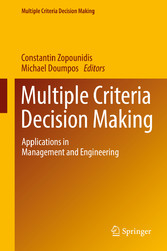
Multiple Criteria Decision Making - Applications in Management and Engineering
von: Constantin Zopounidis, Michael Doumpos
Springer-Verlag, 2016
ISBN: 9783319392929
Sprache: Englisch
218 Seiten, Download: 4380 KB
Format: PDF, auch als Online-Lesen
| Preface | 6 | ||
| Introduction to the Theme of the Book | 6 | ||
| Outline of the Book | 7 | ||
| Acknowledgments | 9 | ||
| Contents | 10 | ||
| Contributors | 12 | ||
| 1 Decision Aid in Public Administration: From Evidence-Based Decision Making to OrganizationalLearning | 14 | ||
| 1.1 Introduction | 14 | ||
| 1.2 Complexity Elements and Challenges | 16 | ||
| 1.2.1 MCDA in Complex Situations | 18 | ||
| 1.2.2 MC Applications Without the Activation of a Decision System | 20 | ||
| 1.2.3 Decision System Open to Participation | 22 | ||
| 1.2.4 Internal PA Decision System and Process | 24 | ||
| 1.3 A Framework to Underline the Main Aspects of an MC Application in PA | 26 | ||
| 1.3.1 Prioritization of Public Investments in Social Infra-Structures Using Multicriteria Value Analysis and Decision Conferencing [6] | 29 | ||
| 1.3.2 An MC Application in the Sustainable Energy Action Plan Ambit [18] | 30 | ||
| 1.3.3 An MC Approach for the Concept Design of a Complex Project [58, 59] | 32 | ||
| 1.3.4 A Knowledge Base and an ELECTRE Tri Application to Facilitate New Financing Actions in the Public Sector [56] | 34 | ||
| 1.4 Conclusions | 36 | ||
| References | 38 | ||
| 2 Measuring Social Responsibility: A Multicriteria Approach | 43 | ||
| 2.1 Introduction | 43 | ||
| 2.2 Measuring the Social Responsibility of an Investment | 45 | ||
| 2.3 Portfolio Selection Model for Socially Responsible Investment | 53 | ||
| 2.3.1 Methodology | 53 | ||
| 2.3.2 Results | 54 | ||
| 2.4 Conclusions | 56 | ||
| References | 57 | ||
| 3 Multi-Criteria Decision Analysis for Financial Investments Using AHP | 59 | ||
| 3.1 Introduction: Banking and Microfinance Institution | 59 | ||
| 3.2 Presentation of the AHP Method | 60 | ||
| 3.3 Financial Institutions Definition | 61 | ||
| 3.3.1 Analysis and Identification of the Project Objective | 61 | ||
| 3.3.2 Develop the Hierarchical Structure of the Project: Risk Definition | 62 | ||
| 3.4 Financial Institutions Analysis Step by Step | 62 | ||
| 3.4.1 The Hierarchical Structure | 62 | ||
| 3.4.2 Pairwise Comparisons for Criteria | 64 | ||
| 3.4.3 Comparison Judgment Matrix | 65 | ||
| 3.4.4 Priority Vector Calculation | 66 | ||
| 3.4.5 Calculation of the Value ?max | 66 | ||
| 3.4.6 Determine the Value of Random Index (RI) | 67 | ||
| 3.4.7 Calculation of Consistency Index: CI | 68 | ||
| 3.4.8 Consistency Ratio Calculation (CR) | 68 | ||
| 3.4.9 Establish the Full Table of Criteria Comparison | 68 | ||
| 3.4.10 Determine the Relative Importance of Criteria | 69 | ||
| 3.4.11 Project Aggregation Calculation | 69 | ||
| 3.4.12 Establish Comparisons by Pair of Studied Alternatives | 69 | ||
| 3.4.13 Determine the Performance of the Alternatives Relatively to the Sub-Criteria | 73 | ||
| 3.4.14 Calculation of the Final Aggregation | 73 | ||
| 3.5 Conclusions and Perspectives | 79 | ||
| References | 79 | ||
| 4 Financing Innovative SMEs | 80 | ||
| 4.1 Introduction | 80 | ||
| 4.2 A Brief Reminder of ELECTRE TRI and SMAA-TRI | 81 | ||
| 4.2.1 ELECTRE TRI | 81 | ||
| 4.2.2 SMAA-TRI | 83 | ||
| 4.3 A Brief Introduction to the Multicriteria Judgemental Rating Model | 83 | ||
| 4.3.1 Selection of the Evaluation Criteria | 84 | ||
| 4.3.2 Definition of the Risk Classes | 84 | ||
| 4.3.3 Assessment of the Criteria Weights | 84 | ||
| 4.4 Case Study | 86 | ||
| References | 91 | ||
| 5 A Multi-Criteria Recommender System Based on Users' Profile Management | 93 | ||
| 5.1 Introduction | 93 | ||
| 5.2 Recommenders Systems | 94 | ||
| 5.3 Multi-Criteria Decision Support | 95 | ||
| 5.4 Machine Learning | 97 | ||
| 5.5 System Description | 98 | ||
| 5.6 System Operating | 99 | ||
| 5.6.1 Introduction | 99 | ||
| 5.6.2 Scoring | 100 | ||
| 5.6.3 Rate Computation | 100 | ||
| 5.6.4 Pairwise Computation | 101 | ||
| 5.7 Experiments and Results | 103 | ||
| 5.8 Conclusions and Perspectives | 106 | ||
| References | 107 | ||
| 6 E-commerce in the Context of Protected Areas Development: A Managerial Perspective Under a Multi-Criteria Approach | 109 | ||
| 6.1 Introduction | 110 | ||
| 6.2 Data and Methodology | 112 | ||
| 6.2.1 Data | 112 | ||
| 6.2.2 Methodology | 112 | ||
| 6.3 Results and Discussion | 117 | ||
| 6.4 Conclusions | 119 | ||
| References | 119 | ||
| 7 Solving a Multicriteria Road Design Problem:A Practical Example | 122 | ||
| 7.1 Introduction | 122 | ||
| 7.2 Research Motivation | 125 | ||
| 7.2.1 An Innovative Approach of Road Design | 125 | ||
| 7.2.1.1 For a Preventive Assessment of Road Safety | 125 | ||
| 7.2.1.2 A Support to Sustainable Road Projects | 127 | ||
| 7.2.2 Towards a Multicriteria Analysis of the Design Process | 128 | ||
| 7.3 Methodology | 129 | ||
| 7.3.1 Multiobjective Evolutionary Algorithm | 129 | ||
| 7.3.2 Multicriteria Ordered Clustering Model | 131 | ||
| 7.3.2.1 The PROMETHEE Methods | 131 | ||
| 7.3.2.2 The FlowSort Method | 133 | ||
| 7.3.2.3 The PCLUST Model | 133 | ||
| 7.4 Case Study: A Rural Road Project in Belgium | 135 | ||
| 7.4.1 Definition of the Problem | 136 | ||
| 7.4.2 Identifying the Approximated Set of Performing Solutions | 137 | ||
| 7.4.3 Solving the Multicriteria Decision Problem | 139 | ||
| 7.5 Conclusions | 141 | ||
| References | 143 | ||
| 8 Locating Ship-to-Ship (STS) Transfer Operations via Multi-Criteria Decision Analysis (MCDA): A Case Study | 146 | ||
| 8.1 Introduction | 147 | ||
| 8.2 The Role of STS Transfer Areas | 149 | ||
| 8.3 The ELECTRE Methodology | 150 | ||
| 8.4 STS Location Problem Definition | 151 | ||
| 8.4.1 Introduction to the Transfer Areas | 151 | ||
| 8.4.2 Addressing a Consistent Family of Criteria | 152 | ||
| 8.5 Results | 157 | ||
| 8.5.1 Weight Determination | 157 | ||
| 8.5.2 Veto Threshold Determination | 160 | ||
| 8.5.3 Concordance Analysis | 160 | ||
| 8.5.4 Discordance Analysis | 161 | ||
| 8.5.5 The Kernel of the Outranking Graph | 162 | ||
| 8.6 Discussion | 162 | ||
| 8.6.1 Robustness Analysis of Criteria Weights | 162 | ||
| 8.6.2 Interpretation of the Results | 163 | ||
| 8.7 Conclusion | 164 | ||
| Appendix 1: Analytical Description of the ELECTRE I Methodology | 165 | ||
| Appendix 2: Short Introduction to the Proposed STS Transfer Locations | 167 | ||
| Appendix 3: Main Characteristics of the Vessel Used in the Practical Example | 170 | ||
| References | 170 | ||
| 9 MCDM Applied to the Partitioning Problem of 3D-Stacked Integrated Circuits | 173 | ||
| 9.1 Introduction | 174 | ||
| 9.2 Multi-Criteria Decision Making Tools: The PROMETHEE Methods | 176 | ||
| 9.3 3D Integration Technology | 178 | ||
| 9.3.1 Implementation | 180 | ||
| 9.4 Case Study | 184 | ||
| 9.4.1 Experimental Set-up: Design and Implementation | 184 | ||
| 9.4.2 Multi-Criteria Analysis | 184 | ||
| 9.4.2.1 High Performance Production Scenario | 185 | ||
| 9.4.2.2 Low Cost Production Scenario | 188 | ||
| 9.4.2.3 Results Interpretation for an IC Designer | 191 | ||
| 9.5 Conclusion and Future Works | 192 | ||
| Appendix | 193 | ||
| OpenSPARC-T2 SoC Design Alternatives: Evaluation Table | 193 | ||
| References | 195 | ||
| 10 A MCDA-Based Approach for Evaluating Alternative Requalification Strategies for a Net-Zero Energy District (NZED) | 196 | ||
| 10.1 Introduction | 197 | ||
| 10.2 Methodological Framework | 198 | ||
| 10.3 Application | 200 | ||
| 10.3.1 Description of the Case Study | 200 | ||
| 10.3.2 Presentation of the Alternative Strategies for Energy Requalification | 202 | ||
| 10.3.3 Definition and Evaluation of the Criteria | 203 | ||
| 10.3.3.1 Energy Performance | 204 | ||
| 10.3.3.2 CO2 Emissions | 204 | ||
| 10.3.3.3 Global Cost | 205 | ||
| 10.3.3.4 Indoor Comfort | 206 | ||
| 10.3.3.5 Energy Surplus Production | 206 | ||
| 10.3.3.6 Green Jobs | 206 | ||
| 10.3.3.7 Real Estate Market Value | 207 | ||
| 10.3.3.8 Construction of the Performance Matrix | 208 | ||
| 10.3.4 Weighting | 209 | ||
| 10.3.5 Aggregation | 210 | ||
| 10.4 Discussion of the Results | 211 | ||
| 10.5 Conclusions | 214 | ||
| References | 216 |








